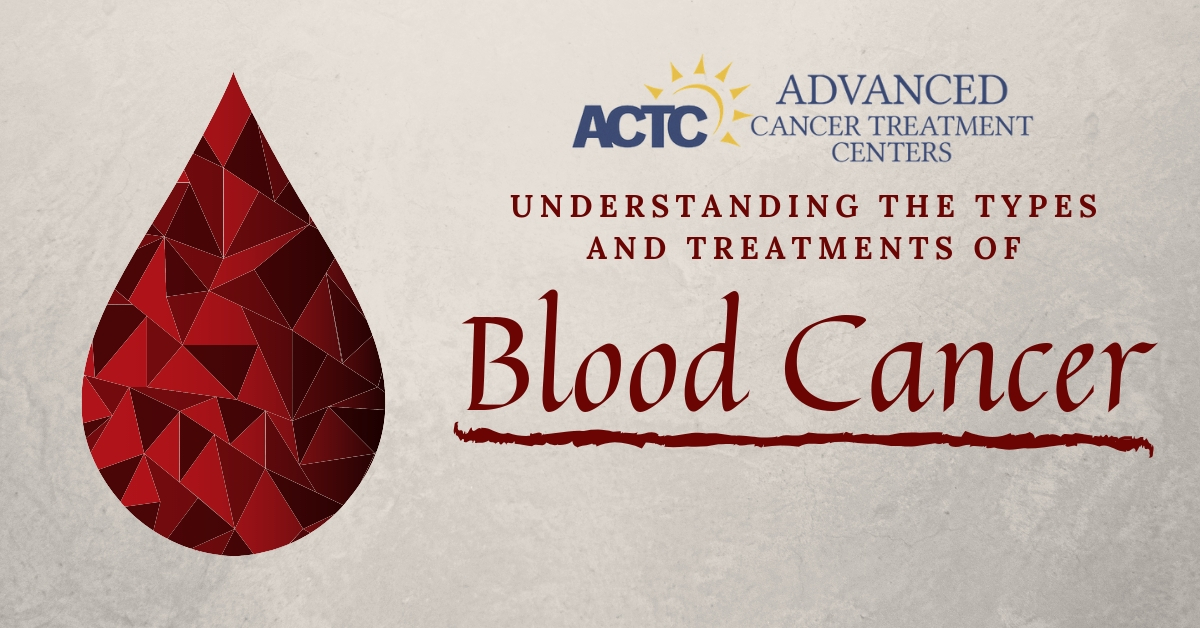
Book a Consultation
Thank you!
Your form has been sent successfully.



March 25, 2021
September is blood cancer awareness month. What is blood cancer? There are many different forms of blood cancer, all of which affect the creation and function of your blood cells. The majority of these cancers begin in your bone marrow. Bone marrow is the soft, jelly-like material that is within the cavities of your bones, which turns stem cells into blood cells. These blood cells include red blood cells, which carry oxygen and remove carbon dioxide, white blood cells, which protect your body from infectious diseases and foreign bodies, and platelets, which help your body to form clots to stop bleeding. Most blood cancers disrupt normal blood cell development with uncontrolled growth of abnormal blood cells. They interfere with the normal functioning of healthy blood cells.
Types of Blood Cancer
Leukemia is a type of blood cancer that is found in both your blood and bone marrow. Leukemia is caused by the production of abnormal white blood cells, which prevent your healthy white blood cells from fighting off infections and weaken the bone marrows ability to produce the different types of blood cells.
There are many different types of leukemia, affecting both children and adults. Acute forms of leukemia require immediate treatment compared to chronic leukemia, which is typically slow to progress. Along with acute or chronic, leukemia is classified as either lymphocytic or myelogenous.
Lymphocytic leukemia means that the abnormal cells that grow in the bone marrow are lymphocytes. Lymphocytes are a type of white blood cell that, when healthy, helps to fight off infection. When cancerous, they make it hard for the body to properly fend off infections and cause the patient to be prone to developing infections. These B lymphocytes are affected by lymphocytic leukemia. T lymphocytes and B lymphocytes. B lymphocytes, also called B cells, stay in the bone marrow after being formed and make antibodies. B cells are the lymphocytes affected by lymphocytic leukemia. T lymphocytes will be discussed further on. Acute Lymphocytic Leukemia (ALL) is the most common form of childhood leukemia and Chronic Lymphocytic Leukemia (CLL) is the most common form in adult leukemia.
Myelogenous Leukemia means that the abnormal cells that grow in the bone marrow are early myeloid cells. Early myeloid cells form red blood cells, non-lymphocyte white blood cells, and megakaryocytes (the cells that make the platelets in your blood). When cancerous, these early myeloid cells hurt the body’s ability to form clots, protect, and transfer oxygen through the body. Acute Myelogenous Leukemia (AML) is common in adults.
Lymphoma is a type of blood cancer that disturbs the lymphatic system. The lymphatic system is the body’s method for removing excess fluids and where the body’s T lymphocytes are located. T lymphocytes, also called T cells, are lymphocytes that travel to the thymus to mature and travel through the lymphatic system to support the immune system. There are many different types of T lymphocytes, each specialized so that the body is protected from germs and other abnormal cells. Cancerous T lymphocytes multiply and build up in your lymph nodes and other tissues, hurting the body’s immune system. Almost half of the blood cancers that occur each year are lymphomas. Lymphomas are classified as either Hodgkin or Non-Hodgkin Lymphoma.
Non-Hodgkin Lymphoma and Hodgkin Lymphoma are very similar except for a few key differences, the biggest being whether there is the presence of a special type of cell called Reed-Sternberg cells. These are large abnormal lymphocytes that often contain more than one nucleus and are only present in Hodgkin Lymphoma. Due to Reed-Sternberg cells, Hodgkin Lymphoma is usually diagnosed at an earlier stage and considered to be one of the most treatable cancers. Due to the lack of these cells, Non-Hodgkin Lymphoma is typically not found until it has reached more advanced stages, making it harder to treat. Non-Hodgkin Lymphoma is the most common between the two types of Lymphoma. In Non-Hodgkin Lymphoma, the blockages in the lymphatic system form anywhere in the body. Hodgkin Lymphoma tends to begin in the upper body, including the neck, chest, and armpits.
Myeloma is a type of blood cancer that affects plasma or white blood cells that produce antibodies that travel throughout the body. Produced in the bone marrow, Myeloma often occurs at multiple sites around the body, which is why it is often referred to as Multiple Myeloma. These cells can prevent the body’s normal production of antibodies, leaving the body open to infection, and interfere with the creation and function of red and other white blood cells. Left unchecked, a high number of these cells can cause kidney damage, pain in the bones, and even fractures.
Symptoms of Blood Cancer
Listed are some common symptoms to watch out for. While these symptoms could be caused by many things, it is a good idea to speak to a doctor if these symptoms are present.
Treatment and Therapy Options
Chemotherapy works by giving the patient anticancer drugs, which target and destroy the fast-growing cancer cells. Chemotherapy is usually given to patients orally or intravenously, directly into the vein. When delivered directly into the vein, often doctors recommend that the patient have a port placed. A port is a device that allows doctors access to the patient's veins to draw blood and give intravenous fluids without the pain of multiple needle pricks. Doctors monitor the patient’s blood throughout the treatment and adjust the medication as needed. While chemotherapy attacks the fast-growing cancer cells, it may also cause side effects. If possible, your doctor may use a combination of drugs to help prevent side effects.
Radiation Therapy works by using “targeted energy” such as x-rays and radioactive substances to shrink tumors, destroy cancerous cells, and treat certain symptoms. Radiation can be given alone or along with other therapies. Imaging advances allow doctors to track the progress of the tumors closely and to be able to deliver large radiation doses directly to the tumors, while avoiding impact on healthy cells.
Stem Cell Transplantation works by giving the patient stem cell intravenously, where they travel to the bone marrow and make new blood cells. This process is called engraftment. The procedure only takes about an hour, but the patient typically must first participate in chemotherapy and radiation to destroy as many of the cancerous cells as possible.
For more information on cancer and its different treatments, follow us on Facebook and Instagram!
Written by D. Maves for Advanced Cancer Treatment Centers


December 24, 2025
It's natural to wonder if testosterone replacement therapy (TRT) is sa...
KNOW MORE

December 24, 2025
A rash that will not calm down is scary, especially when it changes or...
KNOW MORE

December 24, 2025
Florida’s lung cancer burden remains significant and affects many fa...
KNOW MORE

December 24, 2025
A partial hysterectomy, also called a supracervical hysterectomy, is s...
KNOW MORE

December 24, 2025
Finding a rash on your breast can be unsettling, but remember, many ra...
KNOW MORE

December 16, 2025
Hearing a HER2 gene mutation on a report can feel scary, but it also p...
KNOW MORE
